|
January 2008
|
 |
|
Lockheed P-38J late model |
Introduction
I've been an aviation buff from the time I was old
enough to notice airplanes. As a child, any ride in the
car would include a detour past the airport if Dad could
be persuaded; Dad was plane-crazy too, so it never took
much to convince him. During all the considerable
intervening span of time, my favorite airplane, bar
none, has been the Lockheed P-38 Lightning. There's just
something about it that I've always found captivating.
I've been fortunate enough to have seen the P-38 fly at
air shows four or five times. They were always uncommon
in the postwar years and are becoming increasingly rare.
Only a handful of airframes still exist and only a few
of those are flyable. Those that can still fly are flown
carefully and infrequently compared to more common
warbird types.
You can imagine then, my excitement when Just Flight
announced the impending release of their P-38 package. I
managed to acquire one very quickly after it became
available.
The Aircraft
The P-38 is unique. The configuration is unusual and
easily recognizable; it was considered quite
unconventional at the time it was conceived. The
Lightning was designed to meet a US Army Air Corps
requirement for a high-speed, high-altitude interceptor
in the late pre-war years. Originally named Atlanta
(after the god, not the city) by Lockheed, the RAF
re-christened their early P-38s Lightning and that's the
name that stuck.
Designed by Lockheed's famous Kelly Johnson, the
aircraft incorporates some innovative technologies and
was ahead of its day in several respects. Tricycle
landing gear, counter-rotating engines, turbo-chargers
versus the more common engine-driven superchargers and
centreline-mounted guns (including a cannon) were all
unusual for that time. So too was the twin-engine,
single-pilot layout.
Even though the prototype crashed at the end of a very
long demonstration flight, the Lightning met the Army’s
challenging acceptance criteria and was soon put into
high-volume production as the US entry into the war
approached. Though reasonably capable, it soon acquired
a chequered reputation due to technical faults, some
with the airplane itself, some resulting from the
training that was being provided, and some with the
support services that were available, especially fuel
quality.
Considered a mediocre performer as a long-range escort
fighter in the European Theatre of Operations, it was
supplanted in that role by the P-51 Mustang as that
superb aircraft became available. After being largely
displaced as a bomber escort the Lightning was employed
in the ETO primarily for ground attack and
photo-reconnaissance, where specialized variants
performed admirably in both roles.
The story in the Pacific was quite different. Though the
technical faults were known and the training was the
same, the attitude toward the P-38 was very different
from that in Europe. Differences in climate, geography,
and the tactical situation in that region, coupled with
the availability of better quality fuel, combined to
enhance the strengths of the P-38 and minimize its
faults, real and perceived. America's two top scoring
WWII aces, Bong and McGuire, both achieved their record
of victories entirely with the P-38 in the Pacific
Theatre of Operations.
From the J-model onward, the Lightning's technical
problems were largely a thing of the past. Small,
quick-acting dive recovery flaps had solved the
compressibility problem in high-speed dives;
hydraulically-boosted ailerons greatly increased
roll-rate and correspondingly reduced control forces; a
new turbo-charger intercooler arrangement resolved
problems that had earlier led to frequent engine
failures. The late J-model and all of the L-models of
the P-38 (there was only 1 K model) proved to be
superbly capable, effective and reliable. About 11,000
Lightning's were built; nearly 7,000 were of the
definitive J- and L-models.
The Software
Created by Aeroplane Heaven and published by Just
Flight, this eagerly awaited package lives up to
expectations. Supplied in five variants (including the
F4 and F5 photo reconnaissance types but not the
ultimate L model) in seventeen paint schemes, everyone
should find one that pleases them. The external models
are accurate and detailed.
The JF/AH P-38 package is compatible with both in FS9
and FSX. All my flying with it has been in FS9.
The first thing you notice about this package is that
there is no 2-D cockpit provided. When starting you
begin in 2-D mode with an unrestricted forward view;
there’s no part of the aircraft in the view. One press
of the W key brings up a set of seven instruments at the
screen’s bottom edge. These include five of the six
basic flight instruments, but oddly, no gyro compass.
The remaining two are a dual-indicating fuel gauge and
an instrument depicting landing gear and flap positions.
All seven are genuine period-style gauges, not the
FS/Cessna gauges that normally appear here in W-key
view. Though the aircraft can be flown from this view,
it’s a very unsatisfying experience – why would you want
to?
|
 |
|
To quote Elmer Fudd, “Th..th..that’s all,
folks!” |
The Cockpit
So, on to the 3-D cockpit – it’s not as if there’s much
choice. I’m not an expert on 3-D cockpits; I normally
fly the 2-D. This is my first experience spending any
significant amount of time in the 3-D office of any
aircraft. Because of that, I don’t feel particularly
qualified to comment on whether the implementation of
this one is good or bad in comparison to other products.
What I can say is that the cockpit appears to be
authentic – and accuracy appears to have been a primary
criterion for the developers of this package.
The cockpits look and feel right to me and they work.
The authors of this software have gone out of their way
to avoid any hint of a gamey look and feel. For
instance, there are none of the familiar sim-icons
anywhere. The radio and GPS (the hand-held Garmin) can
be accessed via top-line menu pull-downs (or Shft-2 and
Shft-3), as can the ATC window, but you won’t find any
visible controls for anything that wasn’t put there by
Lockheed or the Army.
|
 |
|
Vintage panel |
The radios are vintage, as are all the instruments.
Looking for an HSI, or an OBI or a glide slope? Forget
it, Mac, this is 1944. They haven’t been invented yet.
|
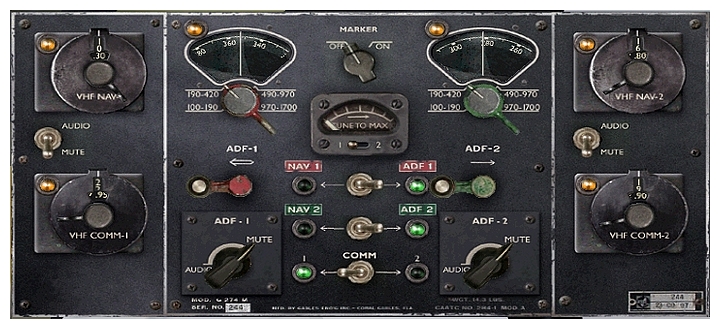 |
|
Transistors won’t be invented for another 20
years or so |
The manual and advertising copy for this package
indicate that the 3-D cockpits are very authentic, and
that the aircraft can be flown “by the numbers” from the
3-D view, including cold starts. This would seem to be
the case. I couldn’t identify anything important that
was missing or that didn’t work. It is necessary,
however, to become familiar with the eye-point controls
for leaning left, right, forward, etc. As must be true
of the real aircraft, you can’t just sit immobile in a
central position and expect to see and reach everything.
Oh, for a TrackIR!
The Lightning has a yoke, not the more common stick.
There’s a deck-mounted pylon on the right side of the
cockpit. At its top, a bar extends horizontally to the
left over the pilot’s legs and it’s on this that the
wheel is mounted. That horizontal bar also carries a
handful of switches and controls. Pitch inputs move the
entire pylon fore and aft through its pivot point at the
deck.
|
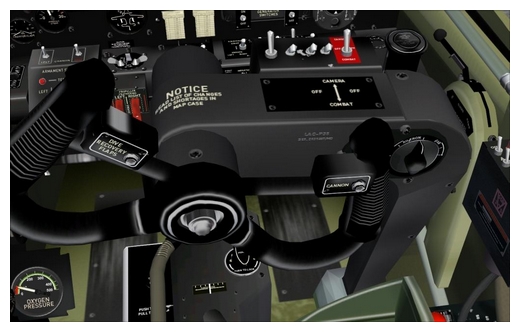 |
|
No stick here… |
There’s quite a lot of variation from model to model in
the panels, equipment and layouts. For instance, both
the J-model combat variants have a huge, hulking, gun
sight and also an extra horizontal frame member at the
bottom edge of the windscreen that blocks a good part of
the forward view. The F5 photo-reconnaissance model has
the frame but not the gun sight. Neither the F combat
model nor the F4 photo-ship have either the sight or the
extra frame member. Forward visibility from them is
considerably better.
In the later models the magnetic compass protrudes from
the panel and masks most of the altimeter, situated just
below it. Most of the altimeter face can be viewed by
leaning forward and left but it’s awkward and
inconvenient, particularly during approaches.
Flying the Lightning
Ground handling is relatively easy. The nose gear
steering is crisp and precise. Even in the models fitted
with the Sight, gun, massive, aviation, view-blocking,
Army, Mark I, Mod 3, the obstructed area of view is
narrow. It’s easy to see both edges of the taxiways and
any impending turnoffs well ahead without swivelling the
view.
|
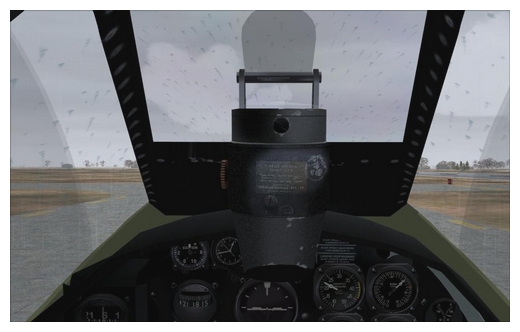 |
|
Ground view |
The engine sound is very good – the suggestion of muted
power is there, but if you’re used to flying Merlins,
it’s not like that at all. Instead of eight-inch long
exhaust stacks, the Allison’s exhausts are routed aft
through the booms to the turbo-chargers on the top of
each, almost as far back as the trailing edge of the
wings. The turbochargers and exhaust plumbing are fairly
effective mufflers and there’s none of that burbling,
barking exhaust noise. You won’t mistake it for a Cessna
however, nor for a radial. Other sounds, flaps, landing
gear, wheel noises and such also seem about right.
When you’re lined up to go and push the throttles,
you’ll experience something unique for a
high-performance propeller AC – or rather you won’t
experience it. There’s no torque, thanks to those
counter-rotating engines. It tracks dead straight, just
goes where you point it, even with the reality sliders
all the way up. If there’s no wind you can take off
without touching the rudder pedals, as long as you’ve
lined up well. It’s one of the things that pilots loved
about the Lightning.
The P-38 with full fuel (including the drop tanks that
are included on every model) is a heavy airplane and it
doesn’t exactly leap off the ground in 1,000 feet.
Maximum weight is on the far side of 20,000 lbs and even
with no weapon load you can expect to be above 16,000
with all the tanks full. Once off and the gear
retracted, initial climb is breath-taking for a piston
engine aircraft. You can exceed 4,000 fpm for a minute
or two, though you soon run out of steam and have to
lower the nose.
|
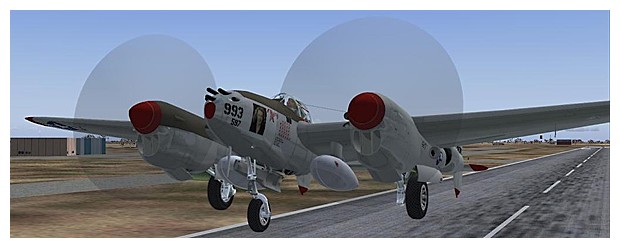 |
|
Off we go, into the wild blue yonder… |
Engine management is important in all phases of flight.
The throttles and manifold pressure gauges are the
primary tools for this; there’s no separate boost
control. At low and intermediate altitude, there’s
enough throttle to easily over-boost the engines, so
keeping one eye on the MP is important when making
changes. Mixture control is, of course, important as
well.
The Lightning is an agile and well-behaved aircraft.
Manoeuvrability is quite good, considering the size and
weight. There’s ample power, but energy management is
necessary. High-g manoeuvres eat away at the airspeed and
can’t be maintained indefinitely. Turn rate is
phenomenal; put the lift line through where you want to
go and pull hard, but watch the airspeed. Roll rate is
good, but not stunning.
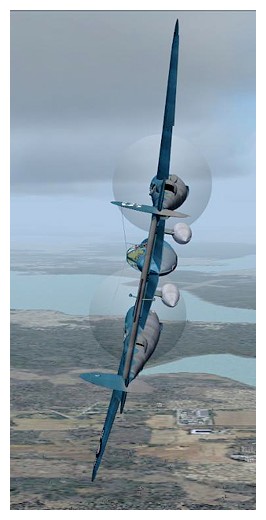 |
This aircraft doesn’t seem to have any bad habits. Stall
recovery is easy and conventional.
The AC must be
bullied into a spin and once in it, recovery is nothing
unusual – lower the nose, reduce power, kick opposite
rudder and you’re flying again.
Bearing in mind I’m not a 3-D guy, I found landings a
challenge.
The P-38 is easy to land – it’s difficult to
land well. Forward visibility is OK with some flaps out
to pitch it down a little, but too much of a good thing
causes problems.
With full flaps the AC will pitch down
a lot. That coupled with the long nose strut means you
have to really haul hard to get the nose high enough in
the flare to touch down on the mains.
I wheel-barrowed
more than one landing and soon learned that two notches
of flap was about all that was easily manageable.
Approach, touchdown and stall speeds are all comfortably
low and long runways are not needed if the approach is
flown reasonably well. |
|
Yanking and banking |
|
|
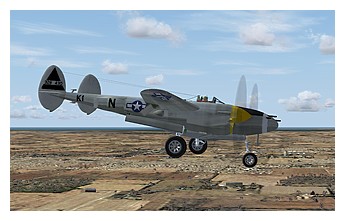 |
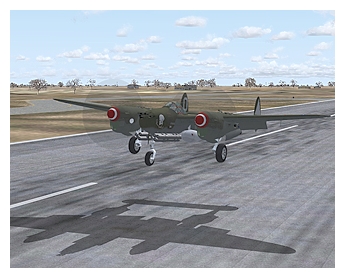 |
|
Full flaps approach |
No Wheelbarrow
here |
In flight, the magnetic compass is “noisy”, just as in
the RW. In every FS aircraft I’ve ever flown, the
magnetic compass is steady as a rock. That’s just not so
in the real world, where you’re taught to only trust it
in “…straight, level, un-accelerated flight”. Someone
took the time to make this one behave realistically, the
first time I’ve seen that.
There’s no index needle on gyro compass. Fly a heading
of 133 degrees? Well somewhere between 120 and 150 ought
to be about right…
Summary
This is a great package modelling a great airplane. Its
immense fun to fly in its own rite, but all the more so
if you have some appreciation for the history of it.
The appearance is excellent. The credit for that has to
be shared between Airplane Heaven and Lockheed, though.
I never get tired of looking at it.
|
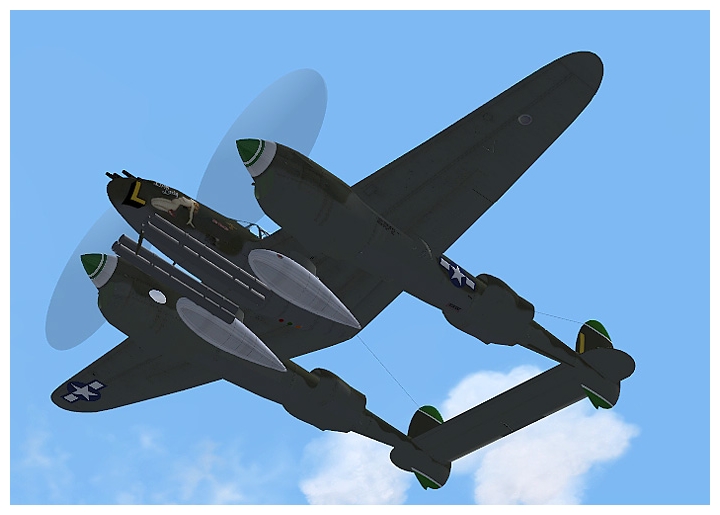 |
|
There’s nothing else like it! |
The external models are quite good and that broad range
of paint schemes, including some nose art, add to the
effect. For some reason, though, the nose art only
appears on the port side. The animations, including an
opened gun bay, are very good. Engine starting has those
counter-rotating propellers cranking correctly, outboard
at the top, and you see the blade pitch adjust just
before they start to turn over. There was a lot of
attention to detail in this production – no doubt a lot
of it escaped me, but I’ll find most of it sooner or
later. I’m certainly not done flying this thing, not
while there’s breath in me.
|
 |
|
Bong’s “Marge”, gun bay open |
This is a very well-done,
very pleasing piece of software. It is clearly intended
to be long on authenticity, on fidelity to the original
aircraft. This appeals to a certain kind of sim pilot.
This is not the sort of aircraft you’ll make long IFR
flights with, though many brave young men, now old or
gone, did that during the war. It’s not likely to be a
good Cargo Pilot airplane or one you’ll buy for your VA.
This package was intended for the aficionado, the
warbird buff, the history lover, the guy who values
realism above convenience
– in a word, for me! Thanks, JF and AH. I love it!
John Allard
|